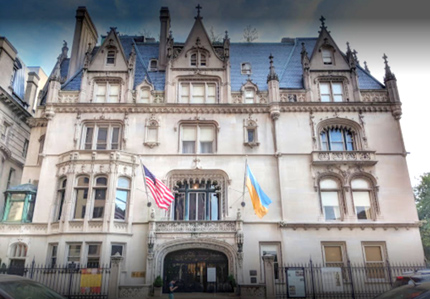
| The Ukrainian Institue of America, The Sinclair Mansions Photo 2016 Pavol Roskovensky |
"The Fiber Effect" at |
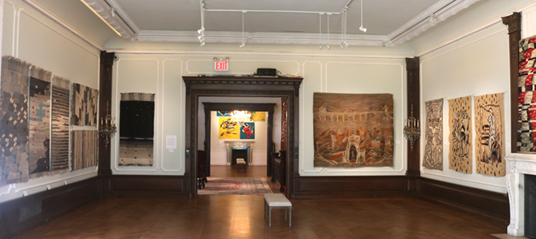 |
"The Fiber Effect" at the Ukrainian Institute
of America — February 24th, through May 17th, 2022 |
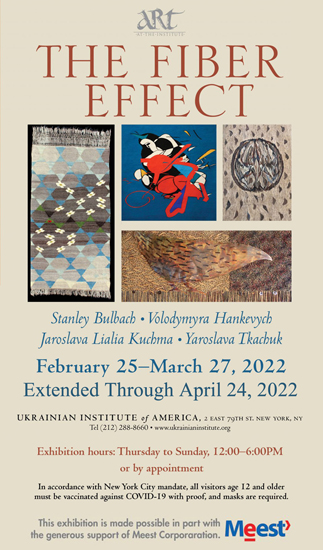 |
Links to help during the current humanitarian crisis: Ukrainian Institute of Amerca Ukrainian
National Women’s League
of America, Inc The Ukrainian Museum, NYC |
PHOTOGRAPHS OF THE EXHIBITED ART Except where specifically detailed, all art works are copyright protected and all photographs of art work below taken by Stanley Bulbach for UIA. |
ART AT THE INSTITUTE is delighted to announce a special exhibition of textile-based artworks by contemporary artists Stanley Bulbach (New York), Volodymyra Hankevych (Lviv, Ukraine), Jaroslava Lialia Kuchma (Chicago), and Yaroslava Tkachuk (Lviv). Ancient cultures knew something that artists, along with new generations of craftspeople, are rediscovering — that fiber (woven, knitted, braided, quilted, crocheted, embroidered) can be an expressive medium, one more powerful, perhaps, than for its ubiquity. Textiles, after all, accompany us on nearly every step of life: we are born and swaddled in it, kept warm by it, buried in shrouds, and are used for cultural identity, ritual and decoration. A renewed embrace of fiber may have something to do with our increasingly virtual world, removed every day of personal contact and interaction. Textiles, in contrast, are earthy and inherently tactile. We describe the “hand” of fabric, meaning the feel of it — whether smooth and cool or rough and grainy. We speak, too, of the “fabric of society,” especially when it is unraveling. The foundation for this project is to encourage discourse on the role of fiber art in society, its cultural and spiritual identity, the exhibiting artists’ creations as expressive discovery, celebration of the handmade, and invoke wonder and that rarest and most coveted of emotions: Joy. Curated by Walter Hoydysh, PhD, Director of Art at the Institute. This exhibition was made possible in part with the generous support of Meest Corporation. |
|
Given the tremendous semiotic capacity of fiber around the world in everyday life — be it as currency, a sign of wealth, a transmitter of political authority, a creator of ties between people and kinship groups, marker of major life passages such as birth, marriage and death, or a constructor of identities and beliefs through dress, domestic adornment, and other types of embellishment — it is no surprise that fiber has become a major medium in contemporary art. Fiber is material natural to humans, yarn is a use of fiber which mankind has invented, and fabric is something everyone uses. It establishes an instant link with the natural world, of which we are an indissoluble part. It is more immediate perhaps than pigment or stone and akin to the basic components of man. Because of these characteristics, abstract ideas can commit to finding a smooth channel of communication through this medium. Drawn to fiber’s aesthetic possibilities, structural potential, and semiotic power, the four contemporary practitioners exhibition here experiment with and adopt some form of the material, utilizing it in innovative ways, exploring its broader associations, from the purely aesthetic to the contextual and conceptual. Their select and collective work demonstrates far-reaching shifts in artists’ interest in and approach to fiber, which in the not too distant past had been dismissed for its historical associations to the “decorative,” “craft,” or “women’s work.” Few aesthetic problems are as perplexing as those involved in defining just what makes up the “minor” arts, or what really differentiates the “high” arts from crafts. Can we discriminate between medieval tapestries and good contemporary weaving, and consider one group as “high” art but the other as craft? Surely, we can agree to make comparisons of equals in quality. Must we not, then either accept a Cellini saltcellar and the Bayeux (France) tapestries as crafts, or good contemporary weaving and mixed-media fiber creations as “serious” art? I use the word “serious” because the term cuts to the quick of the semantic issue. Like “minor,” it is dissonant to me because of the implicit overtones of quality and importance. the work by Stanley Bulbach, Volodymyra Hankevych, Jaroslava Kuchma, and Yaroslava Tkachuk at first glance seem much like craft. that they and their work are “serious,” however, to me is indisputable. The mastery of their methods and their purist attitude toward raw material could not be more in tune with our notion of craft. Yet, there is nothing the least bit functional about half the works displayed in these opulent rooms. Must we conclude, therefore, that only the materials and methods matter? Witness, then, cultural context and personal narrative. To some this exhibition’s title, “The Fiber Effect,” may appear narrow, suggesting a single approach to the making of art, yet, this group show embraces pluralism. It incorporates craft techniques into the story of contemporary art rather than suggesting further segregated categories. It aims to unravel those categories of the “high” and “minor” and to weave together new patterns of thinking about art. These questions and others come to mind as we mount this unique exhibition. I admit that there is not easy solution to defining craft. We will find satisfaction, however, if others are prompted to question the facile labels we often attach to art, arbitrarily, and the assumption that painting is inherently better than weaving, and sculpture than pottery. Categories get in the way of seeing straight or, as I prefer . . . “seeing slowly.” Asking how something is expressed is a deeper question. Andrew Horodysky |
| Celebrating its sixty-seventh year of activity, Art at the Institute is the visual arts programming division of the Ukrainian Institute of America. Since its establishment in 1955, Art at the Institute organizes projects and exhibitions with the aim of providing postwar and contemporary Ukrainian artists a platform for their creative output, presenting it to the broader public on New York’s Museum Mile. These heritage projects have included numerous exhibitions of traditional, modern and contemporary art, and topical stagings that have become well-received landmark events. |
| The Ukrainian Institute of America, Inc. is a nonprofit organization dedicated to promoting the art, music and literature of Ukraine and the Ukrainian diaspora. It serves both as a center for the Ukrainian-American community and as America’s “Window on Ukraine,” hosting art exhibits, concerts, film screenings, poetry readings, literary evenings, children’s programs, lectures, symposia, and full educational programs, all open to the public. |
| PHOTOGRAPHS of THE FIBER EFFECT at UIA |
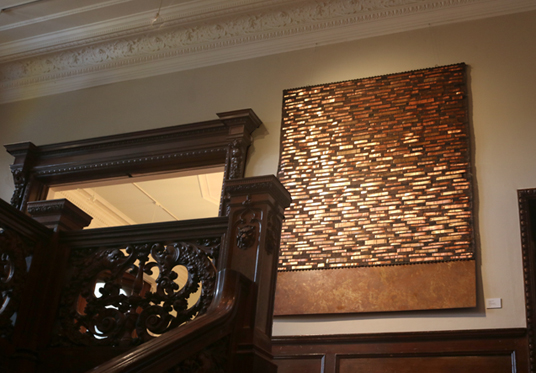 |
The Fiber Effect at the Ukrainian Institute of America Yaroslava Tkachuk— Lviv, Ukraine,"Horizon," 2017 |
| Volodymyra Hankevych Lives and works in Lviv, Ukraine The realization and cross-pollination of traditional fiber practice and new technologies finds relevancy in my works and approach to working with these materials. I maintain a partial footing within the realm of early wool processing by natural dye techniques and carept making in the Yavoriv region in Western Ukraine. Using that as a starting point, I find I can experiment with and visualize new coded language and narrative through the nettng of flax, wool and wire — producing conscious associations with the interwoven referents to coaxial and fiber-optic cables occupying the sphere of entangled information channels. Color is a secondary component to form-making and structural and figurative appearances dictate my compositions. My reaction to and commentary on the evolution of a technology-based society is demonstrated with interweaving and inter-lacing as concrete mechanical action: physical motion and dexterity and spiritual meditation. The resulting works are soaked with the affection of human touch — pulsating, living, reflecting, transmitting light and compelling us to heightened experiences in a pure non-binary aesthetic. |
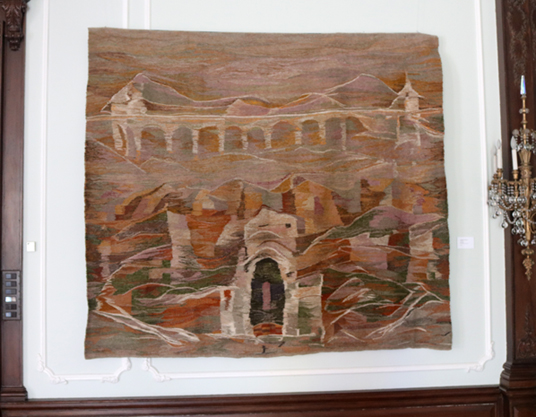 |
| Volodymyra Hankevych — Lviv,
Ukraine
Untitled, 2004, wool and linen 94.5 x 78.5 in. (240 x 200 cm.) |
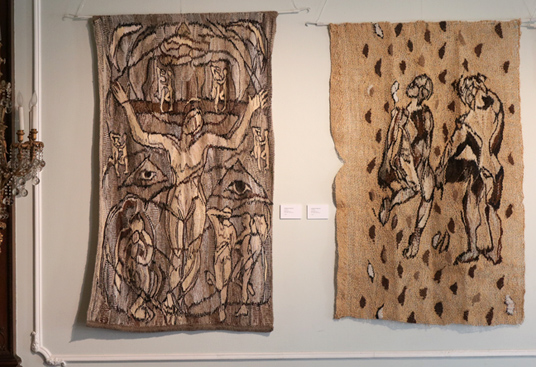 |
| Volodymyra
Hankevych — Lviv, Ukraine |
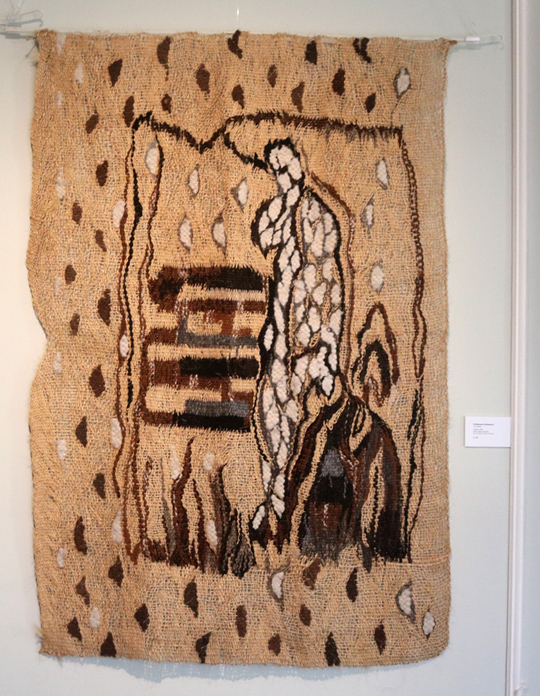 |
| Volodymyra Hankevych —Lviv, Ukraine Untitled, 2009, wool, cotton and linen, 63 x 41.5 in. (160 x 105 cm.) |
 |
| Volodymyra Hankevych — Lviv,
Ukraine Untitled, 2012, wool and linen 94.5 x 78 in. (240 x 200 cm.) |
 |
| Volodymyra Hankevych— Lviv, Ukraine Left: Untitled, 2019, wool and linen 39 3/8 x25.5 in. (100 x 65 cm.) Right: Untitled, 2009, wool, cotton and linen 63 x 41.5 in. (160 x 105 cm.) |
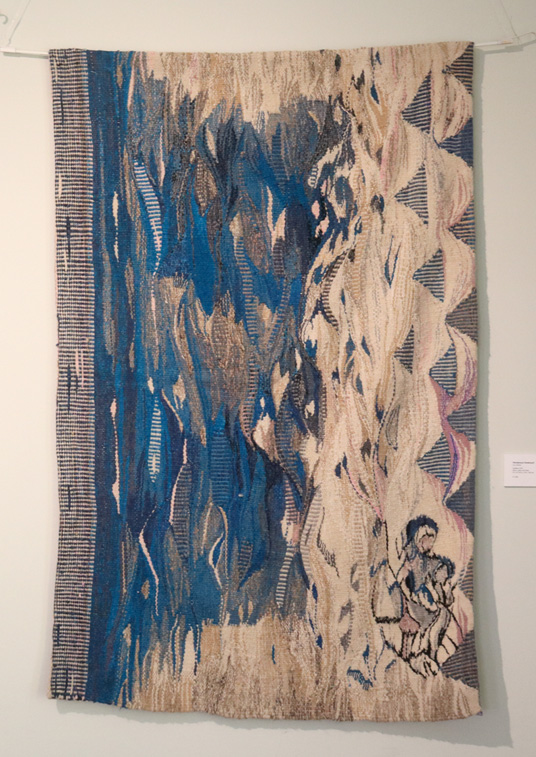 |
| Volodymyra Hankevych— Lviv, Ukraine Untitled, 2019, wool, cotton and linen 59 x 39.5 in. (150 x 100 cm.) |
JAROSLAVA LIALIA KUCHMA “Tapestry is my way of transforming an awareness, an experience, or a commonplace observation. The sources are personal and universal histories. Although the individual histories are nuanced within this framework, they are the foundations from color to line to action.” |
 |
| Jaroslava Lialia Kuchma — Chicago, IL Upper Left: "Urban Turtle," 2007, cotton warp and wool weft 50 x 53 in. (127 x 134.6 cm.) Upper Right: "Yellow/Green," 2014 Cotton warp and wool weft 49 1/2 x 60 in. (99 86.4 cm.) Lower Left: "Jaso," 2020 Cotton warp and wool weft 51 x 48 in. (129.5 x 122 cm.) Lower Right: "In the Month of Eight," 2011 Cotton warp and wool weft 39 x 34 in. (99 x 86.4 cm.) |
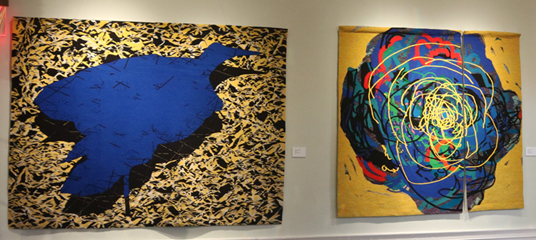 |
| Jaroslava Lialia Kuchma— Chicago,
IL Left: "Crane," 2010, cotton warp and wool weft 61 x 87 in. (155 x 221 cm.) Right: "Blu Rose," 2010, cotton warp and wool weft Two panels, left to right: 54 x 48 in. (163 x 122 cm.) 64 x 23 in. (163 x 57.5 cm.) |
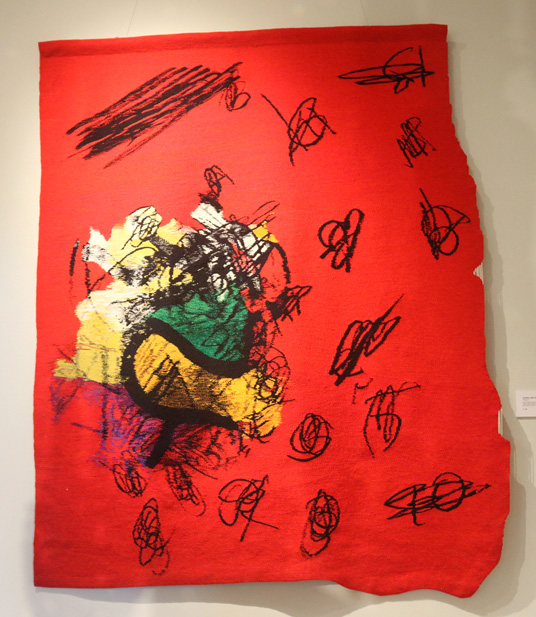 |
| Jaroslava Lialia Kuchma — Chicago,
IL "How to Write a Poem," 2018, cotton warp and wool weft 69 x 58.5 in. (175 x 148.5 cm.) |
| YAROSLAVA TKACHUK Lives and works in Lviv, Ukraine "My artwork [embraces] memories, emotions, and histories, both distant and near. It is not entirely sacred in a classical [sense], but, I believe that the divine could exist in many simple things around us. I try to find exceptional materials, textures and undertones for my works. Still, I always keep natural qualities of the materials in mind, such as those of brass and copper, which gives an incremental range of colours after oxidation, or satin-white melchior, which is especially good in combination with wood. And, I would rather not speak about threads . . . . “I like to experiment with tactile materials, and that
is an essential feature of working with textile, overall, one
of its main [exceptions to] painting, I believe that this material
tactility enables an artwork to convey kindness and love better,
guiding observers’ attention into a positive direction.” |
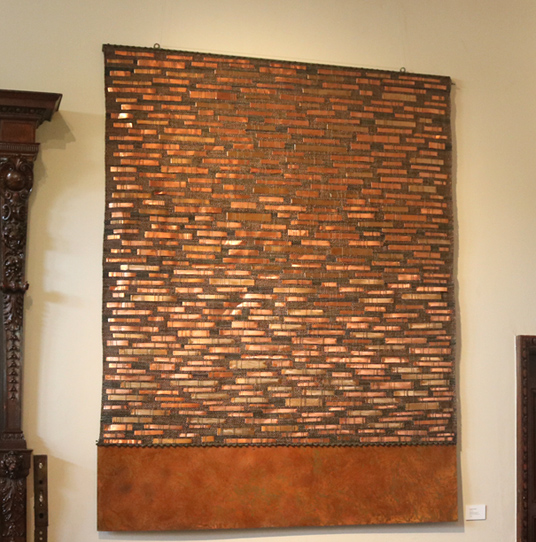 |
| Yaroslava Tkachuk— Lviv, Ukraine "Horizon," 2017, hand-woven gobelin, flax, silk, copper, bronze, and rusted iron 90.5 x 75 in. (230 x 190 cm.) |
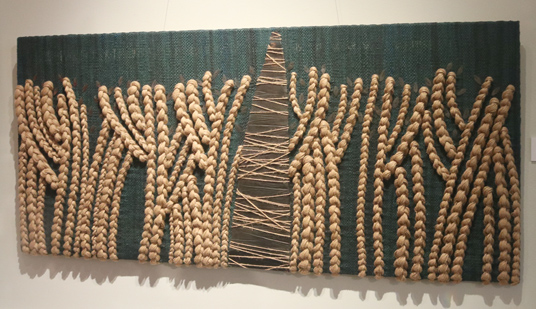 |
| Yaroslava Tkachuk— Lviv, Ukraine "Wonderings Beyond the Skyline," 2016, hand-woven gobelin, flax, and oxidized copper 33.5 x 73 in. (85 x 185 cm.) |
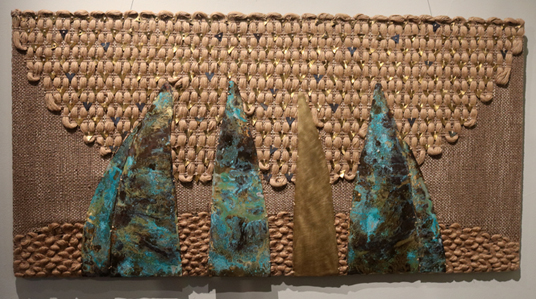 |
| Yaroslava Tkachuk— Lviv, Ukraine "Elect," 2015, hand-woven gobelin, flax, silk, brass and oxidized bronze 34.5 x 69 in. (88 x 175 cm.) |
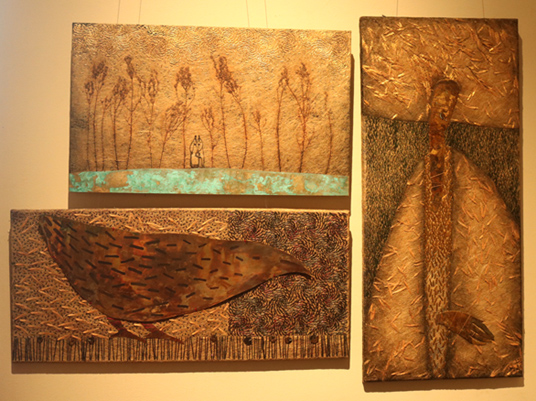 |
| Yaroslava Tkachuk— Lviv, Ukraine Upper Left: "Kupala Night," 2020, pPlant in flax fiber, silk embroidery, oxidized brass and acrylic 17.5 x 29.5 in. (45 x 75 cm.) Right: "Gilded Dreams," 2016, brass and oxidized brass, and gilding 39.5 x 28 in. (100 x 45 cm.) Lower Left: "Nocturn," 2016, handwoven gobelin, flax, and oxidized copper 15.5 x 39.5 in. (40 x 100 cm.) |
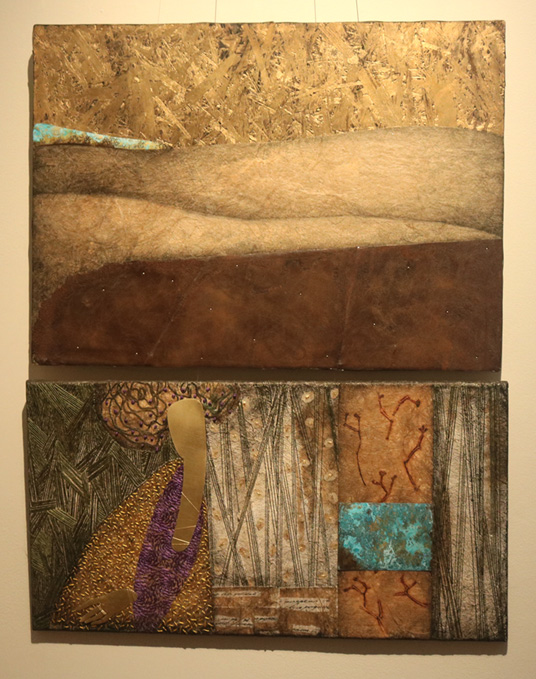 |
| Yaroslava Tkachuk— Lviv, Ukraine Upper: "Iron Water," 2016, gilded wood, flax fiber, oxidized brass, and rusted iron 25 x 33 in. (61 x 84 cm.) Lower: "Conversation," 2015, plants in flax fiber, silk embroidery, brass, oxidized brass and rice paper 18 x 33.5 in. (45 x 85 cm.) |
STANLEY BULBACH "Working on my doctorate in ancient Mesopotamian studies at New York University I learned about the important role of kilims. The weaving arts have been a most important technology driving development in economics, trade, and agriculture as civilizations spread north and west. Kilims were beds upon which life’s passages occurred: conception, birth, dreaming, death, even being buried in them. They transformed the ground for prayer. Traditional literature even has legendary carpets capable of flight. "I find the original uses of this art form to add powerful expressive force to the designs woven within them. The woven structure of kilim art abstracts design element s in ways especially engaging to modern Western eyes. The mathematical structure is musical in favoring pattern, repetition and variation. All this work and more I have shared widely over the past half century in exhibitions and professional publications. "Historically prized throughout
the Middle East and North Africa, kilim arts are now unfamiliar
in most of contemporary Europe. But the kilim arts
are still honored in Ukraine as an important traditional cultural
art. Enjoyed as expressive contemporary art for
the wall, kilim art continues to entice us with its ancient
stories of our
origins still crucially important today.” |
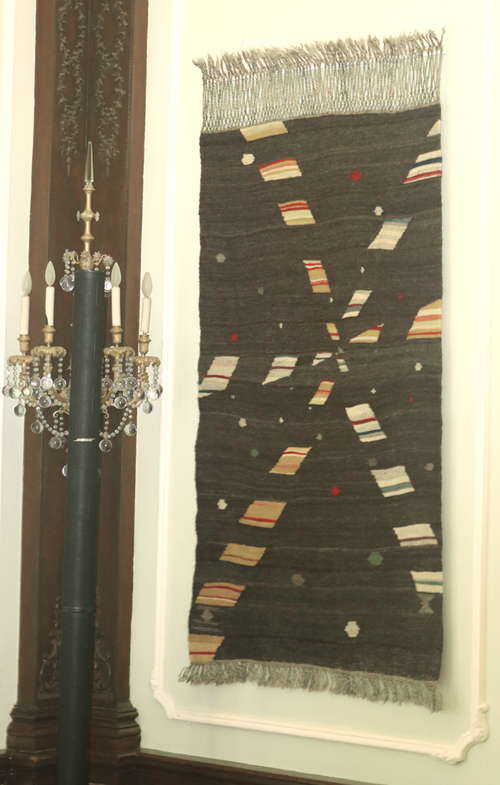 |
| Stanley Bulbach — New York, NY "Times Square" (flying carpet), 2011, handspun lustrous Lincoln longwools and traditional vegetal dyes 79 x 36 in. (201 x 91.5 cm) |
 |
Stanley
Bulbach — New
York, NY
|
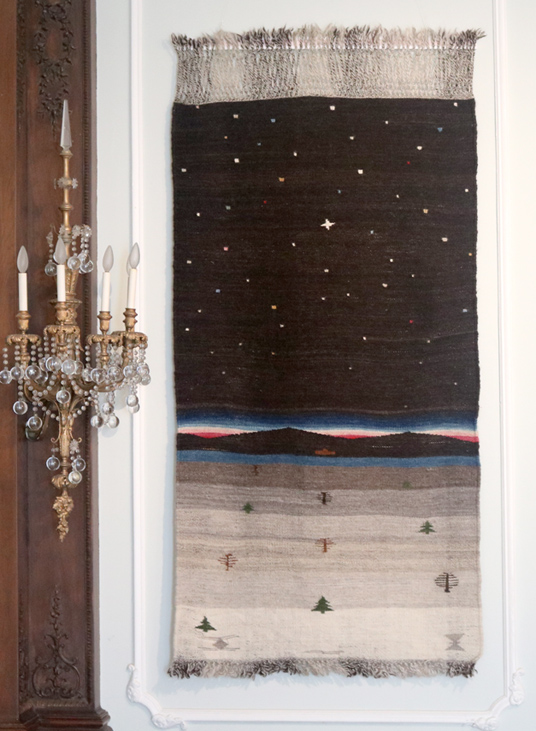 |
| Stanley Bulbach — New York, NY "Ticonderoga Venus" (prayer carpet), 2017, handspun lustrous Lincoln longwools and traditional vegetal dyes 78 x 35.5 in. (198 x 89 cm.) |
| CLOSING RECEPTION, MAY 19, 2022 |
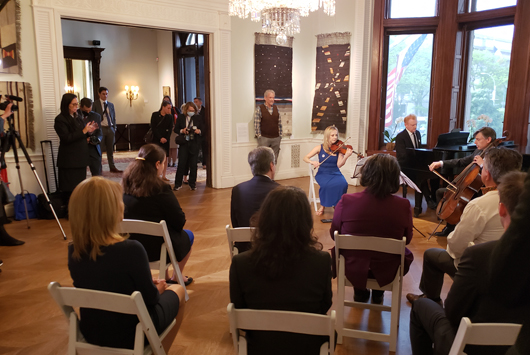 |
| Closing reception, May 17th, 2022, Violinist Solomiya Ivakhiv, Cellist Darrett Adkins, and Pianist Steven Beck. |
| Photo credit and copyright: 2022 Jasper Santa Ana. |
 |
| U.S. Ambassador to the UN Linda Thomas-Greenfield, with U.S. Secretary of State Antony Blinken and Stanley Bulbach. |
| Photo credit and copyright: 2022 Jasper Santa Ana. |
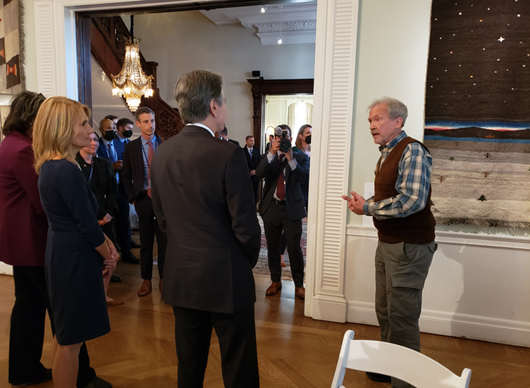 |
| Ukrainian Institute of America President Kathy L. Nalywajko with U.S. Secretary of State Antony Blinken and Stanley Bulbach. |
| Photo credit and copyright: 2022 Jasper Santa Ana. |
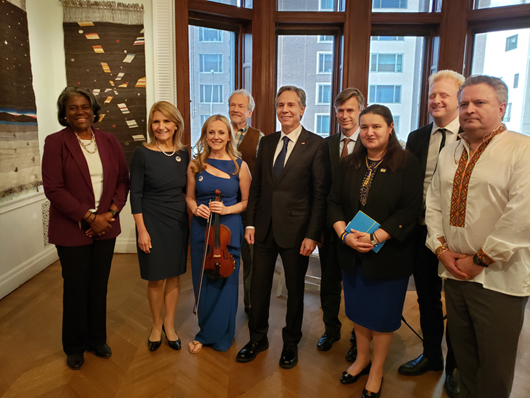 |
| From left to right, U.S. Ambassador to the U.N. Linda Thomas-Greenfield, UIA President Kathy L. Nalywajko, Violinist Solomiya Ivakhiv, Fiber Artist Stanley Bulbach, U.S. Secretary of State Antony Blinken, Cellist Darrett Adkins, Ukrainian Ambassador to the U.S. Oksana Markarova, Pianist Steven Beck, Permanent Representative of Ukraine to the U.N, Sergiy Kyslytsya |
| Photo credit and copyright: 2022 Jasper Santa Ana. |
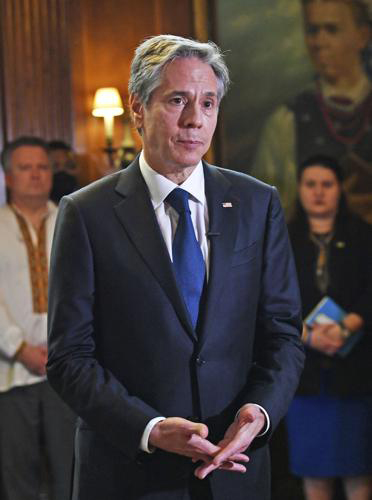 |
| U.S. Secretary of State Antony Blinken, May 19, 2022, speaking about the Ukrainian Institute of America: “This place is a remarkable affirmation of Ukraine’s culture, its heritage, its history, its identity. And it’s a living culture, identity, and one that I am very pleased and proud to have had an opportunity to experience today.” |
| Left, Permanent Representative of Ukraine to the U.N, Sergiy Kyslytsya and right, Ukrainian Ambassador to the U.S. Oksana Markarova, |
| Photo credit and copyright: 2022 Jasper Santa Ana. |